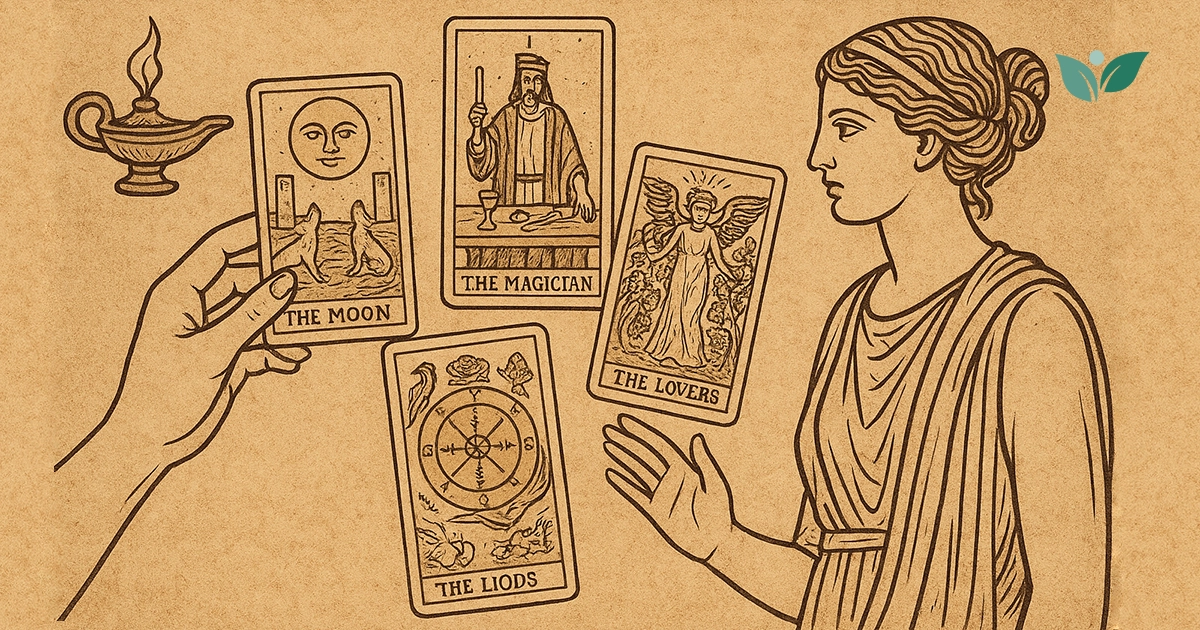Tarot cards are a powerful tool for guidance, introspection, and spiritual growth. While many people start by learning spreads or practicing readings, a deeper understanding comes from knowing each card’s meaning in detail. This article provides a comprehensive card-by-card guide, covering both the Major Arcana and Minor Arcana, upright and reversed interpretations, plus tips for integrating this knowledge into your readings.
By mastering card meanings, beginners and advanced readers alike gain confidence, clarity, and the ability to tell a story with the cards—transforming each reading into a rich and intuitive experience.
Table of Contents
- What Are Tarot Cards?
- Understanding Upright vs. Reversed Meanings
- Major Arcana Card Meanings
- The Fool to The World
- Minor Arcana Card Meanings
- Wands: Ace to King
- Cups: Ace to King
- Swords: Ace to King
- Pentacles: Ace to King
- How to Use Card Meanings in Readings
- Tips for Memorizing Tarot Meanings
- Common Beginner Mistakes
- Journaling & Reflecting on Card Meanings
- FAQs
- Conclusion
- High-Ranking Keywords Sentence
What Are Tarot Cards?
Tarot consists of 78 cards divided into Major Arcana (22 cards) and Minor Arcana (56 cards).
- Major Arcana: Represent life lessons, archetypes, and significant events.
- Minor Arcana: Reflect daily influences, emotions, challenges, and actions.
Each card is a symbol, conveying multiple layers of meaning that depend on context, intuition, and its position in a spread.
Understanding Upright vs. Reversed Meanings
- Upright cards: Traditional interpretations.
- Reversed cards: Blocked, opposite, or delayed energies.
Learning to interpret both adds nuance and depth to readings. Beginners can start by focusing on upright meanings and gradually integrate reversed interpretations.
Major Arcana Card Meanings
0 – The Fool
- Upright: New beginnings, spontaneity, adventure.
- Reversed: Recklessness, hesitation, fear of change.
I – The Magician
- Upright: Manifestation, skill, resourcefulness.
- Reversed: Manipulation, unused potential, scattered energy.
II – The High Priestess
- Upright: Intuition, mystery, subconscious awareness.
- Reversed: Secrets, hidden motives, disconnected intuition.
III – The Empress
- Upright: Fertility, abundance, nurturing energy.
- Reversed: Dependence, creative block, neglect.
IV – The Emperor
- Upright: Authority, stability, structure.
- Reversed: Control issues, rigidity, lack of discipline.
V – The Hierophant
- Upright: Tradition, spiritual guidance, learning.
- Reversed: Rebellion, unconventional approaches, challenging norms.
VI – The Lovers
- Upright: Union, love, choices.
- Reversed: Disharmony, imbalance, difficult decisions.
VII – The Chariot
- Upright: Determination, victory, willpower.
- Reversed: Lack of control, obstacles, scattered focus.
VIII – Strength
- Upright: Courage, patience, inner strength.
- Reversed: Weakness, self-doubt, insecurity.
IX – The Hermit
- Upright: Introspection, solitude, guidance.
- Reversed: Isolation, withdrawal, avoidance.
X – Wheel of Fortune
- Upright: Change, cycles, luck.
- Reversed: Resistance, bad luck, stagnation.
XI – Justice
- Upright: Fairness, truth, law.
- Reversed: Dishonesty, imbalance, unfair outcomes.
XII – The Hanged Man
- Upright: Suspension, letting go, perspective.
- Reversed: Stagnation, indecision, selfishness.
XIII – Death
- Upright: Transformation, endings, rebirth.
- Reversed: Resistance to change, fear of endings.
XIV – Temperance
- Upright: Balance, moderation, harmony.
- Reversed: Imbalance, excess, conflict.
XV – The Devil
- Upright: Bondage, materialism, addiction.
- Reversed: Freedom, release, awareness of control.
XVI – The Tower
- Upright: Sudden change, upheaval, revelation.
- Reversed: Avoidance of disaster, fear of change.
XVII – The Star
- Upright: Hope, inspiration, serenity.
- Reversed: Despair, lack of faith, discouragement.
XVIII – The Moon
- Upright: Illusion, intuition, hidden truths.
- Reversed: Confusion, deception, anxiety.
XIX – The Sun
- Upright: Joy, success, positivity.
- Reversed: Temporary setbacks, pessimism.
XX – Judgment
- Upright: Awakening, reflection, reckoning.
- Reversed: Self-doubt, ignoring guidance, stagnation.
XXI – The World
- Upright: Completion, achievement, integration.
- Reversed: Incompletion, delays, lack of closure.
Minor Arcana Card Meanings
Wands (Creativity & Action)
- Ace of Wands: Inspiration, new opportunities
- Two of Wands: Planning, progress
- …
- King of Wands: Leadership, vision, charisma
Cups (Emotions & Relationships)
- Ace of Cups: New emotions, love, joy
- Two of Cups: Partnership, connection
- King of Cups: Emotional balance, compassion
Swords (Intellect & Challenges)
- Ace of Swords: Clarity, truth, breakthrough
- Two of Swords: Indecision, stalemate
- King of Swords: Authority, analytical thinking
Pentacles (Material & Career)
- Ace of Pentacles: Prosperity, new opportunities
- Two of Pentacles: Balance, multitasking
- King of Pentacles: Stability, financial mastery
How to Use Card Meanings in Readings
- Combine intuition with card meanings
- Consider position in the spread
- Observe reversed cards for blocked energy
- Use storytelling: connect cards to form a narrative
Tips for Memorizing Tarot Meanings
- Start with Major Arcana
- Use flashcards
- Do daily one-card pulls and journal
- Group cards by themes: love, challenges, work
Common Beginner Mistakes
- Trying to memorize all meanings at once
- Ignoring reversed cards
- Over-relying on books instead of intuition
- Reading for others without confidence
Journaling & Reflecting on Card Meanings
- Track daily card pulls
- Note questions, spreads, insights
- Reflect weekly to notice patterns and growth
FAQs
- Can I read tarot without knowing all card meanings? Yes, intuition can guide you, but learning meanings adds depth.
- How long does it take to memorize all cards? With daily practice, a few months for Major Arcana; Minor Arcana may take longer.
- Are reversed cards necessary? Optional, but they add nuance. Beginners can start upright only.
- Do suits have themes? Yes: Wands (action), Cups (emotions), Swords (mind), Pentacles (material).
Conclusion
Learning tarot meanings card by card is the foundation for confident readings. By combining symbolism, upright/reversed interpretations, intuition, and journaling, you develop mastery over time. Every reader progresses differently; patience, curiosity, and daily practice are key.
Tarot is not just a deck of cards—it’s a map to your inner self and a guide for navigating life’s challenges. Start small, study regularly, and watch your readings grow richer and more insightful.


